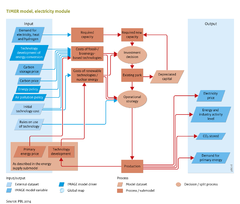Energy conversion: Difference between revisions
Oostenrijr (talk | contribs) No edit summary |
Oostenrijr (talk | contribs) m (Text replacement - "==Introduction==" to "") |
||
| Line 12: | Line 12: | ||
}} | }} | ||
<div class="page_standard"> | <div class="page_standard"> | ||
Energy from primary sources often has to be converted into secondary energy carriers that are more easily accessible for final consumption, for example the production of electricity and hydrogen, oil products from crude oil in refineries, and fuels from biomass. Studies on transitions to more sustainable energy systems also show the importance of these conversions for the future. | Energy from primary sources often has to be converted into secondary energy carriers that are more easily accessible for final consumption, for example the production of electricity and hydrogen, oil products from crude oil in refineries, and fuels from biomass. Studies on transitions to more sustainable energy systems also show the importance of these conversions for the future. | ||
Latest revision as of 15:24, 1 April 2020
Parts of Energy conversion
| Component is implemented in: |
|
| Related IMAGE components |
| Projects/Applications |
| Models/Databases |
| Key publications |
Key policy issues
- What is the potential role of energy conversion sector, particularly in power production, in achieving a more sustainable energy system?
- What are the potential roles of individual technologies, such as carbon capture and storage (CCS), nuclear power, hydrogen and renewable energy?
Introduction
Energy from primary sources often has to be converted into secondary energy carriers that are more easily accessible for final consumption, for example the production of electricity and hydrogen, oil products from crude oil in refineries, and fuels from biomass. Studies on transitions to more sustainable energy systems also show the importance of these conversions for the future.
The energy conversion module of TIMER simulates the choices of input energy carriers in two steps. In the first step, investment decisions are made on the future generation mix in terms of newly added capital. In the second step, the actual use of the capacity in place depends on a set of model rules that determine how frequently the different types of power plants are used. The discussion focuses on the production of electricity and hydrogen. Other conversion processes have only been implemented in the model by simple multipliers, as they mostly convert energy from a single primary source to one secondary energy carrier. These processes are discussed in Energy supply.
Input/Output Table
Input Energy conversion component
| IMAGE model drivers and variables | Description | Source |
|---|---|---|
| Energy policy | Policy to achieve energy system objectives, such as energy security and energy access. | Drivers |
| Air pollution policy | Air pollution policies set to reach emission reduction targets, represented in the model in the form of energy carrier and sector specific emission factors. | Drivers |
| Technology development of energy conversion | Learning curves and exogenous learning that determine technology development. | Drivers |
| Demand for electricity, heat and hydrogen | The demand for production of electricity, heat and hydrogen. | Energy demand |
| Carbon price | Carbon price on the international trading market (in USD in 2005 per tonne C-eq) calculated from aggregated regional permit demand and supply curves derived from marginal abatement costs. | Climate policy |
| Primary energy price | The price of primary energy carriers based on production costs. | Energy supply |
| Carbon storage price | The costs of capturing and storing CO2, affecting the use of CCS technology. | Energy supply |
| External datasets | Description | Source |
|---|---|---|
| Initial technology cost | The costs of energy conversion technologies at the start of the simulation.. | Various sources |
| Rules on use of technology | Rules determining how different types of power plants are used. | Various sources |
Output Energy conversion component
| IMAGE model variables | Description | Use |
|---|---|---|
| Electricity price | The price of electricity. | |
| Secondary energy price | The secondary energy price of each energy carrier at the end-use level (coal, oil, gas, bio-energy, electricity, hydrogen) is calculated based on (1) the primary energy price, (2) energy taxes and subsidies, (3) the costs of energy conversion throughout the energy supply chain and (4) a correction factor. | |
| Demand for primary energy | Total demand for energy production. Sum of final energy demand and energy inputs into energy conversion processes. | |
| Energy and industry activity level | Activity levels in the energy and industrial sector, per process and energy carrier, for example, the combustion of petrol for transport or the production of crude oil. | |
| CO2 stored | The amount of CO2 stored in underground reservoirs by applying CO2 capture technology.. | Final output |
